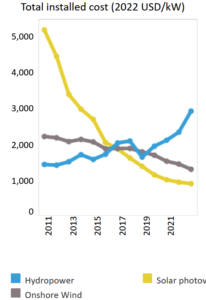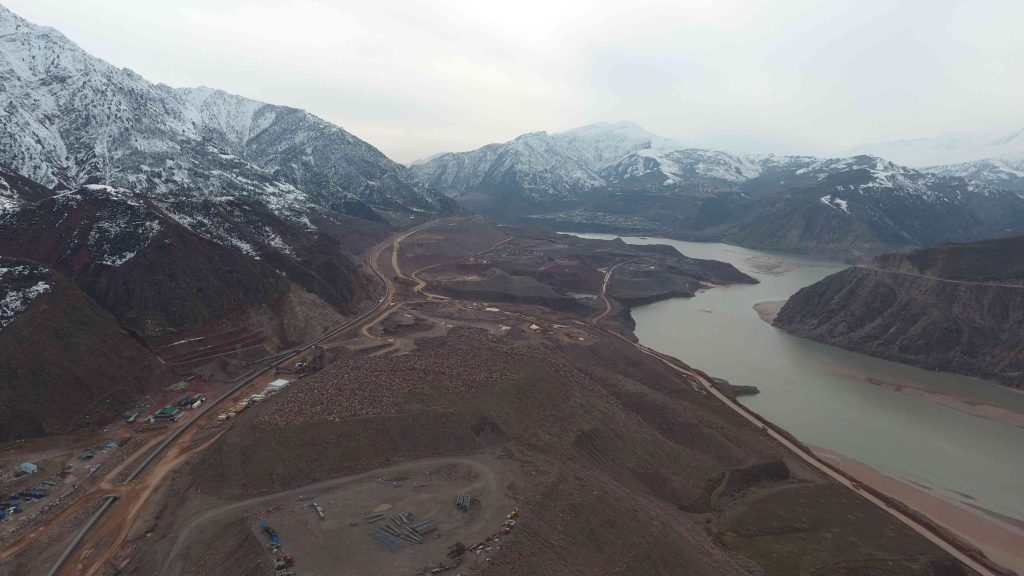Hydropower plants presently generate more than 90 per cent of Tajikistan’s electricity; the Rogun HPP alone will cover 30-40 % of its needs.The risk of over-dependence on a single source has not been considered in the Environmental and Social Impact Assessment (ESIA). Justifying the choice of technology, the ESIA refers to a 2014 (!) report saying, “it was noted that wind and solar power generation cannot make up the shortfall in electricity supply and remains more expensive …” The use of outdated information is a deliberate falsification that does not reflect the current opportunities. Over last decade the average construction costs of solar and wind farms have decreased dramatically, while the installation costs for hydropower plants have increased twofold. Besides, construction period for standardized and scalable solar farms is several months to a year, while any hydropower plant is a unique multi-year project prone to delays and cost overruns. In 2014 newly built hydropower still could look as the most competitive option in renewable energy, while in 2024 it is no longer looks useful as future supplier of base energy, when compared with solar photovoltaics or wind farms.
Today, alternative solar and wind power options could be built five times faster and three times cheaper than the giant Rogun HPP, whose price tag has been rising at a rate of 15 per cent a year since 2008.

Graph:Solar, Wind and Hydropower construction costs. IRENA 2023
In terms of analysis of alternatives, the Rogun HPP ESIA ignores requirements of many World Bank’s environmental-social standards, namely ESS-1, EES-3, and EES-5. The lack of assessment of alternatives makes it impossible to fulfill the key objective of the ESIA “prevention and avoidance of risks and impacts”, as well as to prioritize less carbon-intensive options.
The World Bank’s Environmental Social- Standard 1 (ESS1) requires that socio-environmental assessment be based on up-to-date information. This basic requirement of the World Bank’s ESS 1 has not been met in the Rogun HPP ESIA. It uses 2010 data on alternative methods of energy generation, when construction of hydro was cheaper than construction of solar or wind farms.
The ESS-1 also requires a systematic comparison of alternative methods and conditions of operation of the facilities and their socio-environmental impacts. Contrary to that, the ESIA considers only one regime of water flow regulation by Rogun Dam, referring to the political commitments allegedly made by the Government of Tajikistan. Obviously, this approach is adopted precisely to avoid consideration of any possible downstream impacts of the Rogun HPP downstream of the Nurek HPP. Meanwhile, the ESIA narrative recognizes the possibility of at least three options for water flow regulation, as well as the occurrence of a prolonged low-water periods.
The ESIA should also consider ESS -3 “Efficient Use of Resources” in terms of water use. In the filling phase of the Rogun reservoir, lasting more than 10 years, the annual water consumption of the project will be more than 1 km3, and the resulting reduction in runoff to the Aral Sea will be at least 0.83 km3, which is almost a quarter of the current water flow into the Aral Sea. In such cases, the ESS-3 suggests “offsetting water consumption to reduce total water demand to the level of available supplies, and evaluating alternatives to implementing the project in another area.” These requirements are ignored in the Rogun HPP ESIA.
In the same manner, the ESIA did not meet the requirements of the ESS-6 “Biodiversity Conservation”, in terms of identifying and implementing measures to conserve critical habitats. ESS-6 mandates that “The Borrower shall not undertake any project implementation activities that have the potential for adverse impacts unless the following conditions are met: (a) there are no other viable alternatives for project implementation within the region in habitats of lower biodiversity value…”. Since downstream of the Rogun HPP site there are habitats for two IUCN critically endangered sturgeon species, as well as the UNESCO World Heritage site “Tugai Forests of Tigrovaya Balka Reserve”, the Rogun HPP ESIA had to consider the potential impacts of on these critical habitats and alternatives to the completion of the Rogun HPP project that could mitigate them. For example, locating (part of) the generating capacity elsewhere.
One of the violations of World Bank standards is explicitly documented in the ESIA section on “analysis of alternatives”, which compares three different options for the reservoir that would require resettlement of different numbers of people. The main objective of the World Bank’s standard ESS-5 “Land Alienation, Land Use Restriction and Involuntary Resettlement” is to: “To prevent involuntary resettlement or, if unavoidable, minimize it by considering project alternatives…”.
In the ESIA of the Rogun HPP construction project, the choice of the largest reservoir (with the normal water level at 1290 m asl) associated with the largest resettlement numbers (60,000 people) is justified by additional revenue from electricity exports. Meanwhile, according to the ESIA data, the option with a smaller reservoir (at the water level of 1255 m asl, with 18,000 people resettled) also provides protection against maximum possible floods and satisfies all other key project objectives. Thus, the selection of the highest dam with additional resettlement of 40,000 people directly contradicts the objective of the World Bank’s ESS-5.
Unless all these gaps are carefully considered in the revised ESIA, the Rogun HPP project documentation does not satisfy basic requirements of the World Bank Environmental Social Framework and similar standards of all other international finance institutions.

Photo: Tajik boy reading during winter electricity blackouts, which happen annually due to over-reliance on hydropower (93% of electricity supply in Tajikistan) Photo courtesy of the World Bank Group.
To learn why the Rogun Hydro construction will perpetuate winter blackouts till 2036 and beyond, and how to solve the problem much faster by pursuing alternative development of renewable energy



